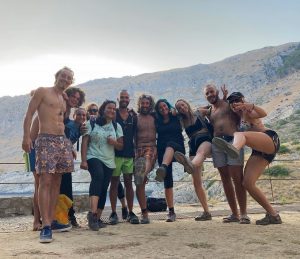Updated on August 6, 2015
In-depth: Posidonia
It’s the symbol of the Mediterranean and develops on sandy bottoms in a depth between 1 and 30-35 meters, where it can benefit from high luminosity.
In fact, as little travellers we have often met it during our walks along the mediterranean coasts, wondering about this «stuff» which prevents us from enjoying the nice beach. This mass of Posidonia on the beach is called «Banquette».
In reality, washed by the waves onto the coast during the winter, it looks to us like some random algae… but have we ever asked ourselves what this Posidonia could be good for and what its importance is in the marine ecosystem?
To tell you the truth, Posidonia is not an algae but a plant living on the seabed. In fact, it produces during its life small flowers and fruits looking like little olives, and it has a root, a stem and leaves. Moreover, its way of reproduction is identical to terrestrial plants. Its role is fundamental for the conservation of the marine world, the protection of the beaches against erosion, and the development of the marine fauna. Like a terrestrial plant, it produces oxygen and feeds a multitude of marine species.
Growing up to one meter in height, it has the capacity to attenuate the force of the waves and the energy of the currents, allowing many animals to find a secure place and to lay their eggs peacefully far away from predators. The surface of its leaves becomes an ideal place for the development of a big number of micro-organisms.
The Posidonia is at this time on the way towards extinction from the seabed of the Mediterranean Sea due to the extensive maritime traffic, for trade as well as turism, and as a consequence of an enormous amount of ancoring. When a boat wants to raise its ancor after stopping in the sea, the anchor also rips out the Posidonia from the depth, and not just the leaves but also the roots, called rhizomes. This can cause the disappearance of vast Posidonia meadows from the seabed within decennia. The vertical growth of the rhizome is very slow: it can take a century to see growth of just one meter of height. The destruction of a Posidonia meadow, due to pollution and disruptions on the ground, can even induce the shrinking of a beach.
Thanks to the collaboration between FAI, the association Simbiotica and the Marine Park of Punta Campanella, the necessity to preserve, after many years of utilization by boats, the Posidonia fields on the seabed of Ieranto Bay has been realised, primarily during the summer season (due to the great influx of tourists). For this reason, access to Ieranto Bay is prohibited for (non-authorized) motor boats, as well as for fishing during a specified period of the year.
Our role is in this regard of fundamental importance: you could say we are the guardians of this bay. Equipped with our kayaks, we explain to boats looking for a peaceful place in the bay that it is not allow to stay here, lower the ancor, and use the motor in order to not disturb the marine species. If they really want to enjoy activities in the bay, they need to use the power of their arms to row or use the sail (if they have a sailing boat). Else they can come via the 40 minute-walk from Nerano, with beautiful views well worth the effort.
 After the work of project MARE volunteers and, previously, the volunteers of the association Simbiotica, researchers have been able to observe a great development of the Rhizomes. This means a lot to us and the nature, and implies that we really need to continue in this way for the coming years. This will allow the Posidonia and other species to have time to develop and escape from this turistic invasion during summers.
After the work of project MARE volunteers and, previously, the volunteers of the association Simbiotica, researchers have been able to observe a great development of the Rhizomes. This means a lot to us and the nature, and implies that we really need to continue in this way for the coming years. This will allow the Posidonia and other species to have time to develop and escape from this turistic invasion during summers.
To conclude, this positive impact is very important for the development of the marine fauna and flora but also for the important professional activities of the region, that is fishing. This way, everyone can have their piece of the cake. If we allow marine species time to develop and reproduce, it will be beneficial for them as well as for us and our future generations.









